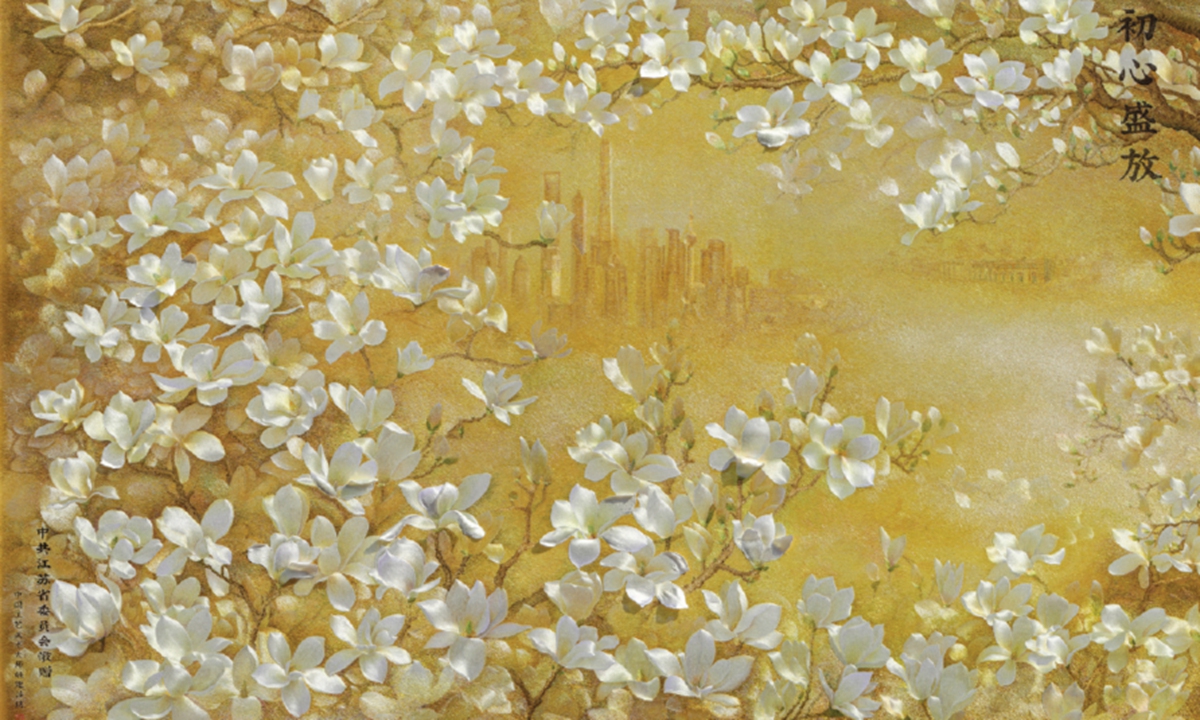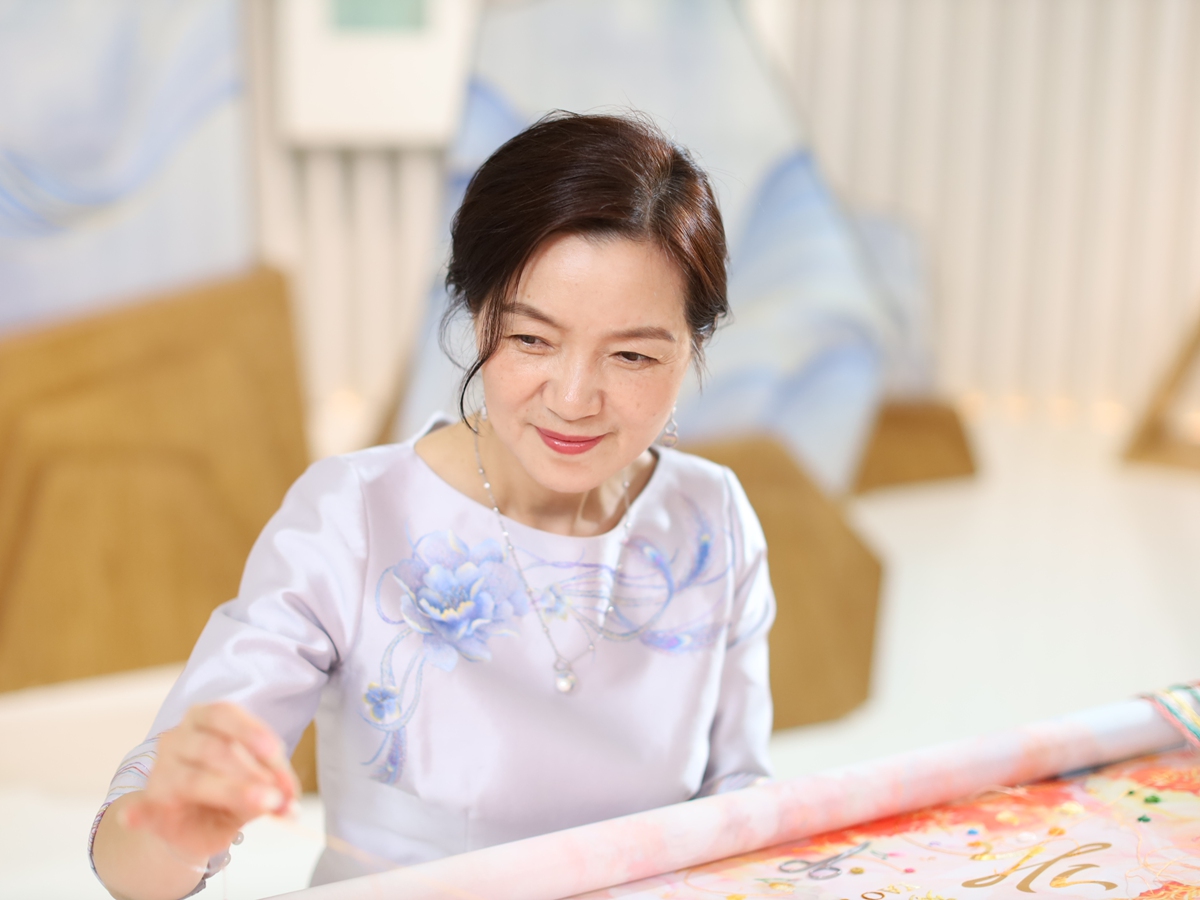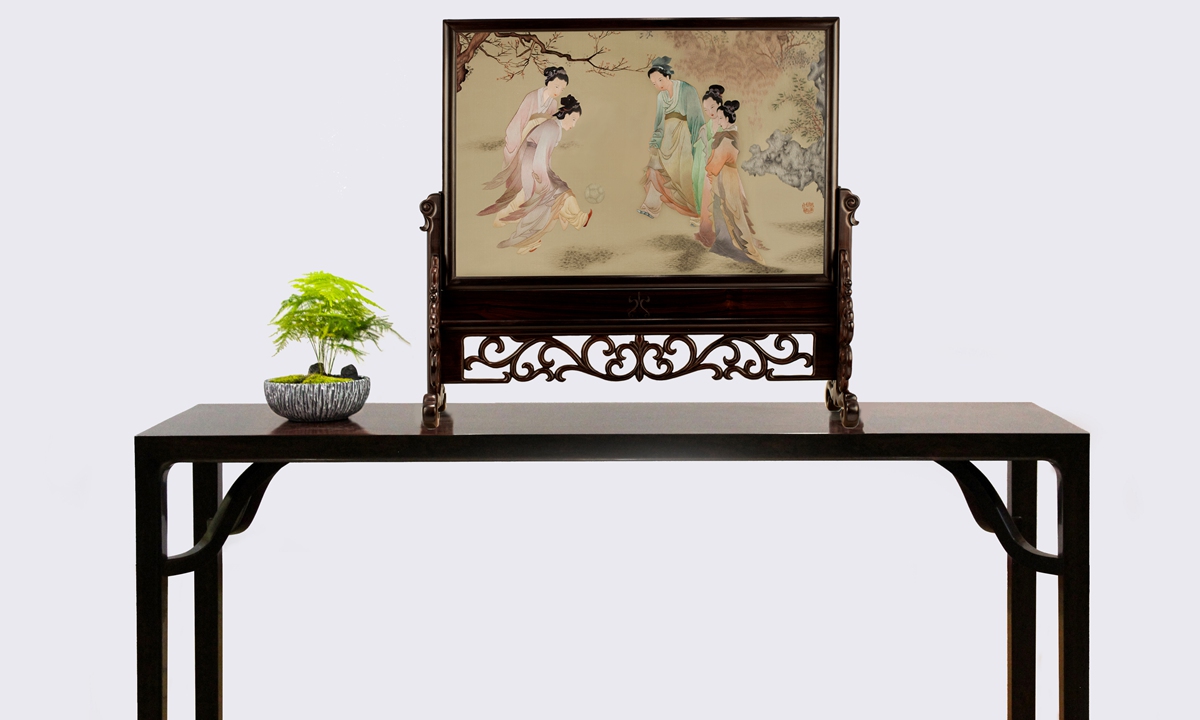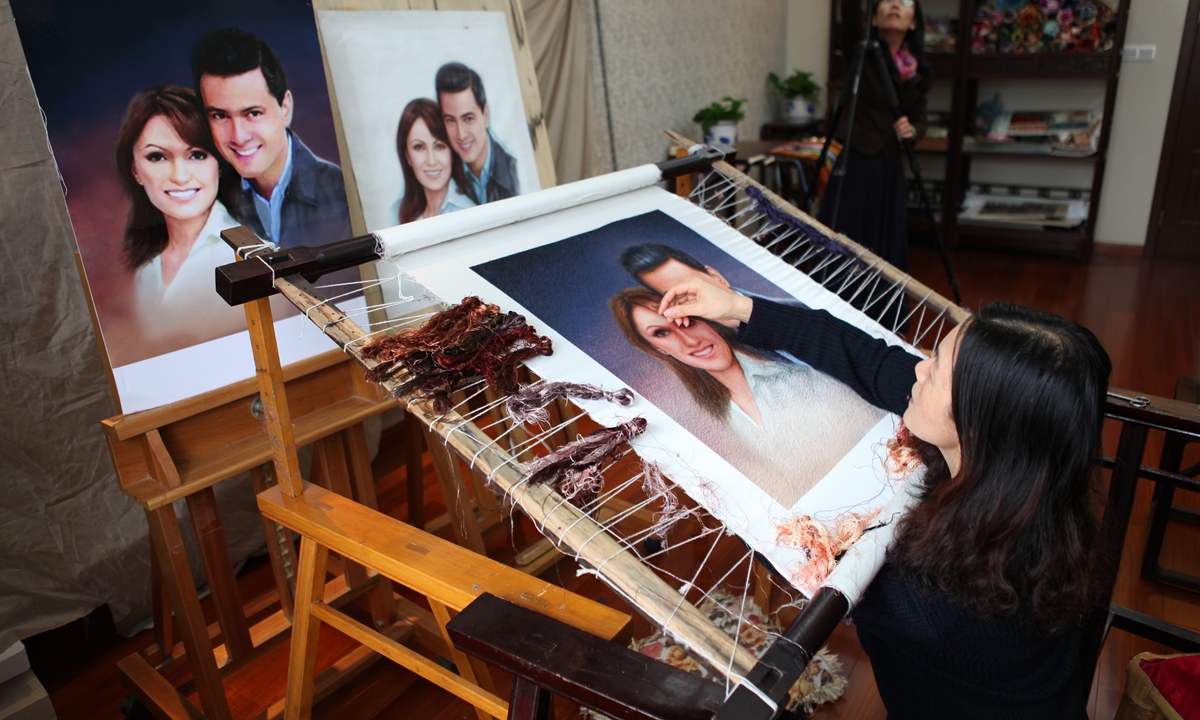ARTS / CULTURE & LEISURE
Cultural Influencer: Yao Jianping brings millennia-old Suzhou Embroidery into future with works that define times

Suzhou Embroidery Chuxin Shengfang, or Original Aspirations in Bloom, by Yao Jianping Photo: Courtesy of Yao Jianping
With a simple needle moving up and down on a piece of cloth, a delicate flower begins to take shape under her hands.
Watching Yao Jianping doing embroidery is just like watching a ballet performance of fingers; it is both elegant and skillful.
Ever since she was a young girl, Yao, a well-known artist from Suzhou, East China's Jiangsu Province, has been creating Suzhou Embroidery, one of the oldest embroidery techniques in the world and the most representative type of Chinese embroidery.
In this issue of the Cultural Influencer series, the Global Times sat down with Yao at her studio in a suburban town of Suzhou, the birthplace of the craft, to explore her unique artistic style as well as get her thoughts on how to adapt this fine traditional art to modern times and make it a daily part of people's everyday life.

Yao Jianping Photo: Courtesy of Yao Jianping
All she needs are a needle and a few silk threads, then with her magical hands, anything can happen. Her traditional techniques and innovative skills have not only won her the title "Master of Folk Arts and Crafts" from UNESCO but also the nickname "Queen of Suzhou Embroidery."Yao Jianping was able to complete an embroidered tie on her own when she was 12 years old. "I have not let go of this embroidery needle all the way to today. It can be said that Suzhou Embroidery has threaded its way through my entire life," Yao told the Global Times.
After inheriting the skills of her predecessors, Yao created a unique artistic style of this millennia-old art that she uses to depict the era of today. She has not only produced a series of works representing the highest level of contemporary Suzhou Embroidery, but also managed to get the fine art to reach more ordinary people, especially the young.
She has become better known around the world in the past few years since her works began being presented as national gifts to world leaders. In 2015, British Queen Elizabeth II received a fine piece of Suzhou Embroidery as a gift from visiting Chinese President Xi Jinping and his wife Peng Liyuan.
The gift, Song of Life, was a vivid portrayal of the Queen and her husband Prince Philip, Duke of Edinburgh. A total of 1.18 meters in length, the work took Yao and her assistants more than three months to complete.
Many of her works have been included in the collections of important institutions, including the Great Hall of the People, the National Museum of China and the Buckingham Palace.

Suzhou Embroidery Shinü Cuju Tu, or The Picture of Ladies Playing Cuju, by Yao Jianping Photo: Courtesy of Yao Jianping
Magic handsAs early as the Spring and Autumn Period (770BC-476BC) and the Warring States Period (475BC-221BC), the smart and dexterous women of Suzhou, famous for silk since ancient times, would trace pictures on their clothing and then embroider these designs with silk threads in five colors. The result was clothing that made them appear elegant, graceful and charming.
After more than 2,000 years of evolution, Suzhou Embroidery, one of the four most famous types of Chinese embroidery, has developed a unique style featuring elegant patterns, ingenious designs, exquisite needlework, clever stitches and graceful colors.
Zhenhu Town is the cradle of Suzhou Embroidery. Possessing a long-standing local culture and atmosphere related to the craft, the small town has cultivated many internationally recognized embroidery masters.
Born to a Suzhou Embroidery family, Yao, like other girls in the town, has a pair of skillful hands.
Yao's grandmother and mother made a living from embroidery, so from a young age Yao helped her family plant mulberry leaves and rear silkworms and watched her mother thread needles.
She began to learn embroidery from her mother when she was 7 or 8 years old. By the age of 17, she focused solely on improving her skills at Suzhou Embroidery, which had been "integrated into my life."
Yao often describes her career of embroidery as "persisting out of love," as she started by following her mother and then learned from a renowned teacher.
"It has been a part of my life," she said.
She was surprised to see the striking embroidery works from masters when entering the Suzhou Arts and Design School to study.
Seeing how far her own skills were from these masterpieces, Yao realized that she had to learn more and receive guidance from famous teachers. On her way to study, she met Xu Zhihui, an expert from the Suzhou Embroidery Research Institute.
It takes a moment to discover beauty, but it takes a long time to create beauty. After studying for four years, she finally transformed her art from the level of "looking life-like" to "being alive."
Even after all these many years, Yao still remembers very clearly one piece that was displayed at the central position of the exhibition area at the Yao Jianping Embroidery Art Gallery. This piece was based on the renowned photo of former premier Zhou Enlai captured by Italian photographer Giorgio Lotti in 1973. The photo is now known in China as Zhou Enlai in Deep Thought.
In 1996, transferring the image to an embroidery piece took Yao eight months as it required "not only great patience and skills, but also innovation and courage."
"Keeping a peaceful mind is very important as a short piece takes months to finish and a long one may take several years to complete. Being an embroiderer is like practicing Buddhism in life," Yao told the Global Times.
Three years later, the work won the gold medal at the First China International Folk Art Expo for its fine texture, tasteful colors, natural contrast between light and dark and vivid depiction of its subject.
Yao was conferred the title "Master of Folk Arts and Crafts" by UNESCO. More importantly, the honor gave Yao great confidence in her skills at figure embroidery.

Yao Jianping works on Suzhou Embroidery. Photo: Courtesy of Yao Jianping
Part of spiritual lifeThe more works she finished, the more innovation and changes that she hoped to accomplish. Eventually, Yao created a unique technique called rongzhenxiu, or integration needle embroidery.
"For an artist, the soul of their work is innovation deeply rooted in tradition," Yao said. "The characteristic of rongzhenxiu is to integrate content with artistic expression and combine that with the indirect nature and gracefulness of South China art and a passion for innovative culture. I want to create works that define this era and the times."
Recruiting young students and professionals, she has continuously explored and made breakthroughs in terms of theme and size of her works, composing the melody of this era with a small needle.
She has led her team in completing one breathtaking project after another, from large-scale Suzhou Embroidery works such as What a Great Land, Harmony: China's Centenary Olympic Dream Realized and The Silk Road series to a dozen of works presented as national gifts. Among these works, The Silk Road - Returning Home with Great Honor from The Silk Road series took Yao and her team three years to complete, which they did in 2017. After being used in a number of activities related to foreign affairs, the piece is now in the National Art Museum of China's collection.
In Yao's eyes, with Suzhou's thousands of years' cultural accumulation, Suzhou Embroidery carries the tastes of South China's intellectuals, which is also part of the spiritual life of South China. Its exquisiteness not only lies in the material used, silk, but also craftsmanship and needle work.
"Between light and shadow, imagination and reality, it is quite similar to xieyi, or freehand brushwork," she said.
Only by respecting traditional culture and holding a special love for Suzhou Embroidery can artists develop the art form and create beauty with their hands just like Yao.
Elegant and modern
Through many years of working on embroidery and based on her inheritance and innovation, Yao has developed an embroidery style that integrates various methods that have come to be known as the Yao school.
Her works not only inherit the delicate stitch work and elegance but also integrate modern features and fashionable beauty, making the art form "a good way to tell Chinese stories."
Since the very beginning, Suzhou Embroidery has always been on the road of inheritance and innovation.
"We changed as the times changed. With our needles, we embraced innovation as we needed to make new designs for young people and meet their needs," Yao said.
At the 2023 two sessions, namely the National People's Congress (NPC) and the National Committee of the Chinese People's Political Consultative Conference (CPPCC national committee), Yao, an NPC deputy, submitted a motion promoting creative transformation in China's handicraft industry.
She recommends that the industry form a more "complete industrial chain," noting that the current scale of the industry still relies on "individual studios" and "small workshops," and these creative units do not have "strong brand awareness."
"Handicrafts have gradually become 'high-end luxury' products and so they struggle to appeal to common consumers," she noted.
The NPC deputy said she believes traditional handicrafts are "cultural properties" more than mere "commodities" as the handicraft industry opens a door for China's rural revitalization and tells Chinese stories to the world through art.

As "China chic" becomes increasingly trendy across the country, Yao and her two daughters have started to launch new lines of products with Suzhou Embroidery elements, from fans and scarfs to Chinese qipao dresses.
Through designs and Suzhou Embroidery, they can "walk into young people's lives, being worn and used, as a way to show our cultural confidence."
Besides working on new projects, Yao also puts her energy into promoting the traditional craft through various other ways.
When a specially designed skin featuring Suzhou Embroidery was introduced for one of the in-game characters of China's popular role-playing game Kings of Glory, also known as Honor of Kings, it immediately became a hit among young people.
To popularize embroidery, Yao and the team also produce simple and easy-to-follow lessons about the art form that allow students to finish works on their own. They also upload these lessons to social media platforms and short video sites.
"After all, it is still my hobby, my life and my world."

